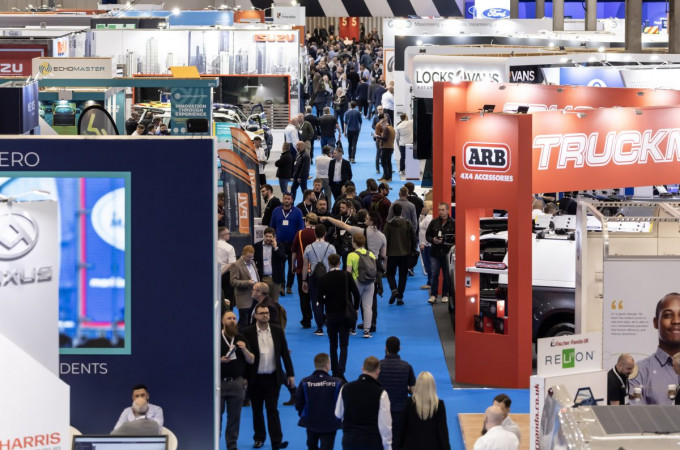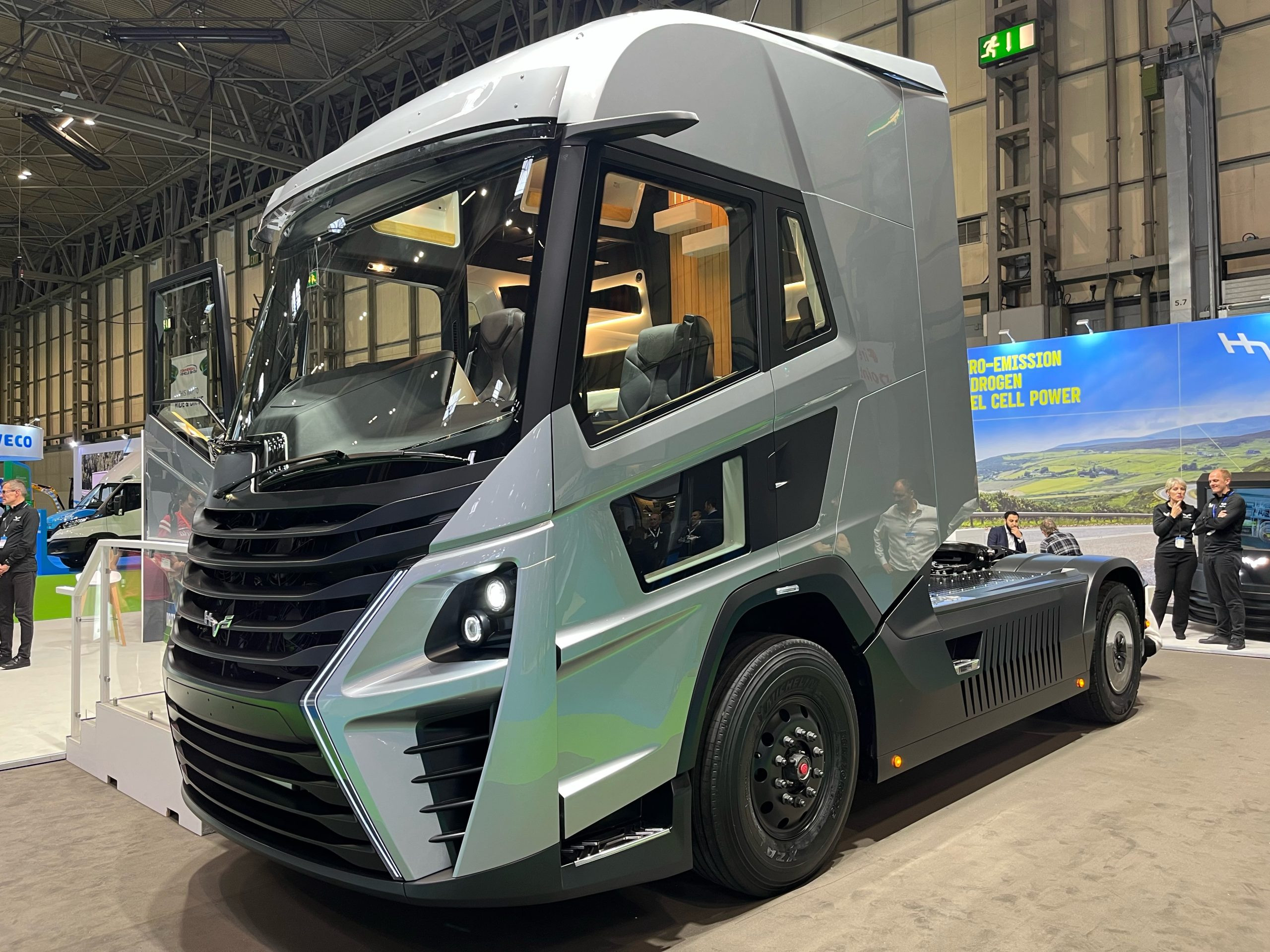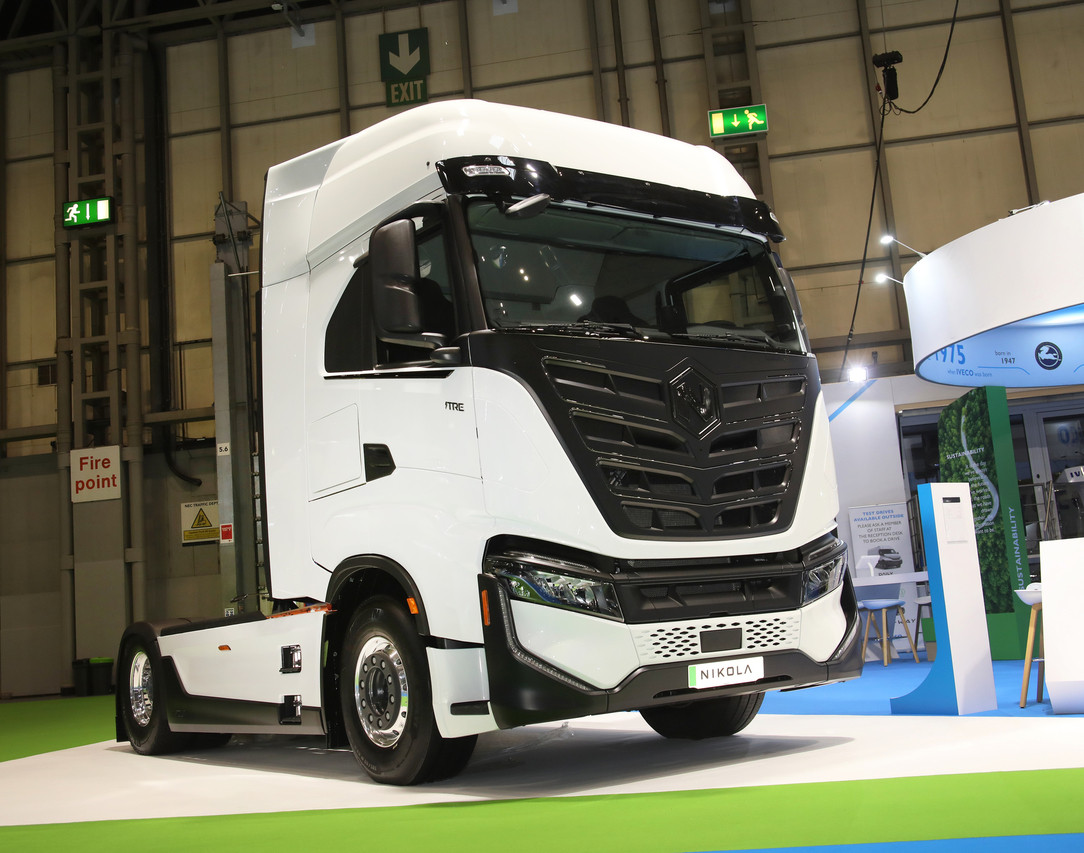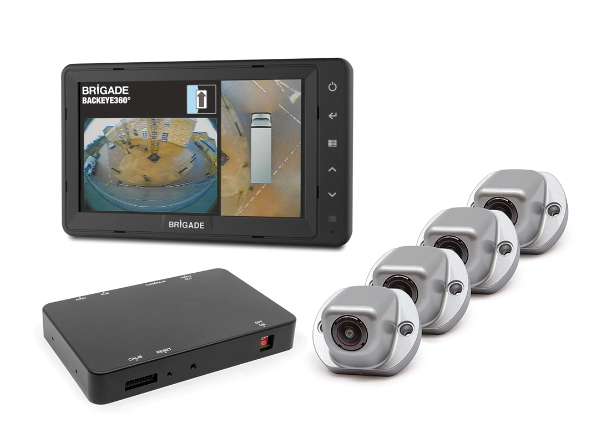2023 Commercial Vehicle Show Report
By Luke Willetts - 2nd May 2023

2023 CV Show
The 2023 Commercial Vehicle Show in Birmingham from the 18th – 20th of April, was an exciting time for the UK truck market with 223 exhibitors displaying their new product offerings. The T&BB team was in attendance to bring you all the latest news from the show.
Vehicle Launches
Formed in 2017, Glasgow-based start-up manufacturer, Hydrogen Vehicle Systems Ltd (HVS), launched the UK’s first hydrogen-electric 40-tonne Heavy Goods Vehicle (HGV) technology demonstrator model to much fanfare. Designed for long-distance transport haulage, Peter Clarke, engineering director at HVS said that the articulated tractor unit can travel up to 370 miles (595km) per refuel, with a refilling time of just 20 minutes. Further vehicle development is currently being undertaken at Horiba MIRA in Nuneaton, Warwickshire. HVS has said in no uncertain terms, that its objective is to be the first UK-designed and developed hydrogen-electric HGV on the market, and with the recent financial backing of the EG group, they just might get there. In terms of immediate plans, the company has been expanding its staff complement by hiring industry specialists, in the automotive, energy, hydrogen technology, power electronics, sustainability and environmental management fields in order to meet production deadlines. Pre-series production is anticipated to start at the beginning of 2025, with production being ramped up in late 2025 for UK customers.

Launch of the HVS hydrogen-electric 40-tonne truck at the CV show
Clarke reiterated that the HVS tractor is built on an in-house designed chassis around the hydrogen powertrain consisting of pressurised hydrogen cylinders, fuel cells, an energy storage system and an eAxle. The design is focused on enhanced fuel efficiency on long-haul runs and improved spatial ergonomics within the cab, designed to help operators meet future operational commitments and target driver comfort and driver retention, respectively. all the key powertrain components in terms of batteries, fuel cells, hydrogen storage and the e-axle have been outsourced.
The Iveco Group debuted the latest generation of its battery-electric Daily (eDaily) for the UK market. This vehicle has been pitched as the electric twin of the traditional standard Daily, which means the same body shape, driving ability and load capacity as the diesel models. The heaviest 7.2-tonne model will offer up to 19.6 cubic metres of loading space, a maximum payload of 4.6 tonnes and a towing capacity of 3.5 tonnes. Iveco claims that this electric Light Commercial Vehicle (eLCV) has the tightest turning circle amongst its peers. There are lighter variants weighing between 3.5 and 5.2 tonnes, but those models have lower payloads with the entry-level eDaily able to carry a maximum of 2.2 tonnes. The 4.25-tonne vehicle has a payload of 2.7 tonnes. Every version of the van uses the same rear-mounted electric motor with 190hp and 400Nm of torque.

Iveco 7.2-tonne eDaily
The company has made use of a modular battery system that allows the owner to add and remove battery capacity to suit the changing needs of their business. Iveco claims that this process takes around 2 hours at any Iveco dealership. This flexibility is a key advantage for operators as these various battery options offer operators a multitude of applications. Operators can choose to install one, two or three 37kWh battery units, meaning you can have a van with a 37kWh, 74kWh or 111kWh battery capacity. This will provide a maximum of 248 miles (400km) on a single charge with the latter option as the eDaily allows for rapid charging of up to 80kW, enabling 62 miles (100km) of range to be added in 30 minutes. The batteries are guaranteed to retain 80% of their capacity for eight years or 155,000 miles (250,000km).
At the CV show, we interviewed Mike Cutts, Iveco’s Light Business Line Director. Cutts said that the large towing and payload capacities will allow Iveco to gain some market share due to its capabilities. Cutts added that EVs do not necessarily mean compromise and hoped that displaying the vehicle at the CV show would allow clients, journalists, fleet operators and the general public to see that. He mentioned that Iveco UK has partnered with electric vehicle charging manufacturer, Pod Point Ltd, to supply eDaily customers with the necessary charging equipment on a referral basis. Pod Point will offer Iveco eDaily customers discounted prices on AC charging equipment (7kW up to 22kW chargers).
The Nikola Corporation / Iveco SpA partnership was in full force, displaying the pre-production Nikola Tre 4X2 battery-electric heavy-duty tractor unit on the Iveco stand. Already on trial with 50 customers across mainland Europe, the vehicle initially will be available in left-hand drive in the UK market, with right-hand drive models expected in the near future

Launch of the Nikola Tre 4X2 battery-electric heavy-duty at the CV show
The Nikola Tre platform is based on the Iveco S-WAY diesel and gas-engine powered trucks but fitted instead with an electric 480-kW continuous power e-axle co-designed and produced by FPT Industrial SpA, and Nikola, producing 645 HP and 1,800Nm of instant torque. The design team adopted a modular approach to this platform so that it is capable of hosting both battery and fuel-cell propulsion technologies. The vehicle features nine battery packs with a total energy storage of up to 738 kWh, which delivers a range of approximately 500 km. Charging takes 162 minutes, with a 175-kW charger but the vehicle is capable of rapid charging at 350kW, achieving 10-90% battery capacity in just 100 minutes.
AI-powered perception technologies at the show
From 7 July 2024, all new vehicles registered in the European Union will need to comply with the latest set of vehicle safety regulations. These will require all new road vehicles to be installed with more advanced assistance and safety technologies which employ some of the developments being made at the cutting edge of artificial intelligence.
The European Commission will require newly registered vehicles to be installed with devices for intelligent speed assistance, reversing detection, driver monitoring, event data recorders, and emergency stop signalling. Additionally, trucks and buses will need systems for blind-spot detection, collision warning, and tyre pressure monitoring.
Safety regulations which will come into effect in Greater London in October 2024 will impose similar requirements for heavy goods vehicles operating in the capital. Currently, Transport for London’s ‘Direct Vision Standard’ (DVS) requires that HGVs over 12 tonnes achieve a one-star rating, based on an assessment which measures the driver’s direct view of their surroundings through the windows of their vehicle cab. When the new regulations come in, HGVs will require a three-star rating. Those vehicles which do not comply will need to be fitted with advanced monitoring systems and sensors to identify vulnerable road users and eliminate blind spots.
The second half of 2024 might still feel like a long way off, but for OEMs and operators alike there is no time to waste in equipping their vehicles to ensure compliance with both sets of regulations. As such, there were multiple tech firms at the show exhibiting products which were designed with the EU and TfL’s safety directives in mind. They told T&BB that multiple OEMs were in discussions with them about integrating their technologies with new truck and van models.
While there is some variation in the products these firms are offering, the fundamentals are the same across the board. They depend on a combination of AI-driven software and advanced cameras fitted on all sides of the vehicle and inside the cab. The cameras monitor the vehicle’s blind spots and the driver at the wheel. The AI perception systems can differentiate between a pedestrian and an object, warning the driver when the former enters the blind spot with a visual and/or aural signal. They can also identify drowsiness or inattentiveness in the driver and produce a similar warning to bring their attention back to the road.
The firms present at the CV Show are software developers first and foremost. The hardware is made in Asia, following each firm’s required specifications. While there is an obvious legal context behind the development of these products, they have other potential applications, such as in semi-autonomous vehicles.
The first company T&BB spoke to was VisionTrack of Tunbridge Wells. Richard Lane, Commercial Director at the company, claimed it had exclusive agreements to offer its products to customers through MAN and Scania dealerships. Its monitoring systems are connected to a cloud-based platform which stores and analyses any videos uploaded to it. VisionTrack’s software will comb through many thousands of hours of video and pick up significant “events” where, for instance, the vehicle was involved in a near-collision. Lane said that VisionTrack’s technology would help minimise operational risks for fleets and their insurance providers, making it easier to determine liability when claims are made.
VisionTrack’s hardware is supplied from China, but Lane assured that there was no chance of any spyware being installed in the equipment. The company recently expanded its operations to the U.S., opening an office in Long Beach, California – a market which VisionTrack would be unable to tap were its technology compromised by state-sponsored spying from China!
Netradyne of San Diego, California was founded by two former employees at telecommunications giant Qualcomm. Its visual perception systems are reportedly able to read road signs and assess the speed of other vehicles. Moreover, its driver monitoring systems assess the driver’s behaviour and provide a score based on whether they are driving safely and efficiently. Like VisionTrack, Netradyne uses the cloud to store and analyse data (through Amazon Web Services). The hardware is manufactured in India, and Netradyne also has an office in the city of Bangalore.
Exeros Technologies based in London also offers smart perception systems for eliminating blind spots and monitoring driver behaviour. Its products are geared even more towards protecting operators from false claims and theft than VisionTrack’s. In addition to storing video on the cloud, Exeros retains a physical event data recorder as part of its product offering so that visual data is backed up in multiple places. Up to 10 terabytes of data can be stored on Exeros hardware.
Brigade Electronics Plc recently launched a new road safety product for rigid vehicles, Sidescan Predict, comprising six sensors using ultrasonic technology that alerts the driver to potential vehicles, objects and pedestrians, and is designed for collision avoidance within a detection area of 2.5 metres. Brigade explained the algorithm is constantly being fed object detection data such as distance, speed, direction, acceleration and turning rate of vehicles and objects to calculate the risk of a collision. The product has also been accredited by the Driver and Vehicle Standards Agency (DVSA) as an effective road safety product, in large part due to its seven-year, 10,000-hour cycle of testing.
Thierry Bourgeay, Senior Product Manager at Brigade Electronics gave us a presentation of the new generation of active blind-spot detection AI cameras known as Backeye 360. An intelligent four-camera system which provides the driver with a complete 360-degree view of their vehicle in a single image aiding the driver to manoeuvre these blind spots.

Backeye 360
Finally, CameraMatics showcased products developed by three teams based in Dublin, Ireland, in Macclesfield, UK, and in Lisbon, Portugal. Its perception systems link to the cloud, where customers can access analytics which CameraMatics claims will help reduce costs as well as supporting driver training and development. Visual data stored on the cloud is analysed by AI and can be used to support insurance claims. CameraMatics claims Renault Trucks as a partner.
Telematics and connected vehicles at the show
T&BB spoke to two companies who presented connectivity products and services at the CV Show. One was Internet of Things specialist Samsara Inc of San Francisco, California. A representative showed us the company’s primary offering, the ‘Connected Operations Cloud’ for comprehensive fleet management. The user can track vehicles in real time and check workflows and reports automatically logged on the system. Depending on what data the vehicle transmits, the operator receives information such as vehicle speed, performance, fuel or energy consumption, and how many hours the driver has been on the road and how long they have left until their next statutory break.
Integrating Samsara’s platform with an OEM’s own data cloud is a straightforward process. The company works with its partners to ensure that its software can communicate with the OEM’s respective cloud platform. Fleet operators can therefore access their vehicle data directly from Samsara’s Connected Operations Cloud. Manufacturers who have partnerships with Samsara in North America include Volvo Trucks and Stellantis. Samsara reportedly designed its hardware – sourced from Taiwan – for easy (i.e., “plug and play”) installation.
While Solera Inc of Westlake, Texas offers a similar service to Samsara, it places greater emphasis on driver behaviour and operational risk management. Products such as ‘Solera Protect’ and ‘Solera SmartDrive’ are more driver-centred, giving drivers real time feedback to improve their safety and efficiency. Solera Protect is billed as a “streamlined” version of the latter, “designed to cater to the needs and budgets of smaller fleet operators, who require immediate risk reduction for minimal outlay”. Solera was also showcasing ‘RoadNet Anywhere’, its answer to the fleet management market with route optimisation and remote vehicle monitoring tools.
MAN’s ‘Driver App’, which is free to use, was developed by Solera. Using their mobile, the driver can log any issues with their vehicle during their pre-departure check. It provides the driver with their personal performance data, which is taken directly from the vehicle’s Rio telematics. The app also provides remote access to MAN’s customer services and digitised user manuals.
Solera’s fleet management solutions are based on products which it acquired when it bought three different American companies in 2021: Omnitracs; DealerSocket; and eDriving. Solera is now made up of nearly 7,000 employees across the world, in places such as Mexico, Spain, and East Asia. Alongside fleet management, Solera also works with insurance providers and automotive dealers on software products for streamlining vehicle claims and repairs.
SMMT’s recommendations for HGV charging infrastructure
The CV Show coincided with the publication of a position paper by the Society of Motor Manufacturers and Traders (SMMT), which represents the motor industry in the UK. Titled ‘Charging and Refuelling Requirements of the Heavy Goods Vehicle Sector’, it puts forward a series of recommendations which it would like to see implemented in government strategy by Spring 2024. At the show, SMMT’s Environmental Manager, Sukky Choongh, summarised the paper’s key points.
The SMMT is calling for a simplified process for installing charging and refuelling infrastructure in fleet depots which is the same across the country. In particular, the SMMT is requesting that the government instate a consistent and coherent process for connecting depot chargers to the grid that is understandable to fleets and to distribution network operators.
Public charging infrastructure needs to account for the different needs of heavy goods vehicle operators. Choongh was unable to say exactly how many service stop charging bays on the UK’s motorways are suitable for trucks, but from anecdotal and personal experience she could inform her audience at the show that some of these clearly were not designed with larger and heavier vehicles in mind. The SMMT is recommending that chargers are made available every 50 kilometres on the UK’s main roads, and that these are present in truck rest stops as well as service stations. It suggests that government conduct research with the freight sector to design a public network which accommodates HGV driving patterns.
Finally, the SMMT is calling on the government to encourage operators to share their charging infrastructure with each other. By designing a mechanism for operators to collaborate in installing and sharing chargers, the government could increase the coverage of the country’s infrastructure while also reducing the cost of building and maintaining it for those who use it.
The SMMT recognises that HGV fleets will need a combination of public and private charging in order to switch out their diesel vehicles with electric ones. Choongh confirmed, however, that the UK government has so far offered no incentives whatsoever to fleet operators to develop their own depot-based infrastructure. Operators also face barriers put in place by authorities and landlords unwilling to grant planning permission for chargers on private land.



